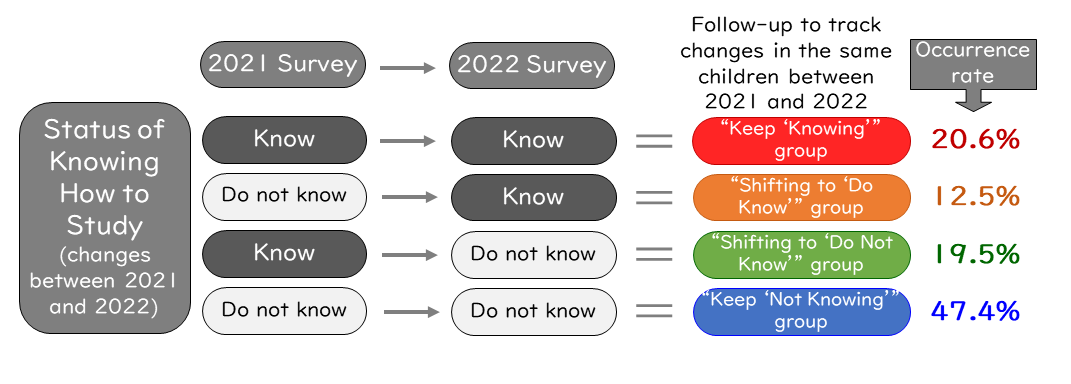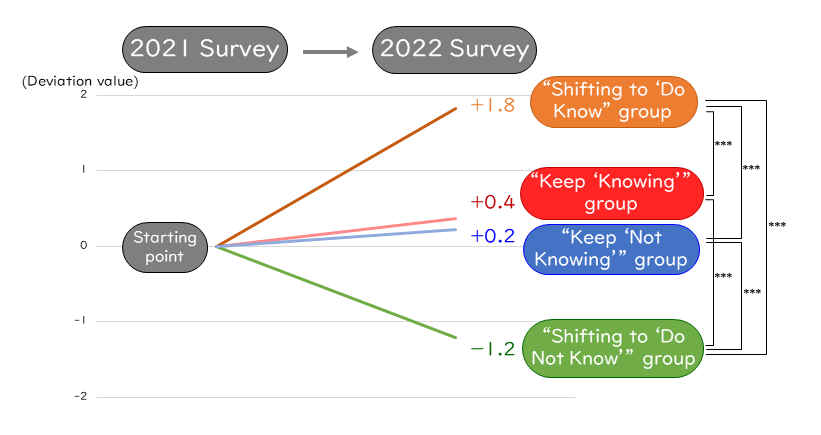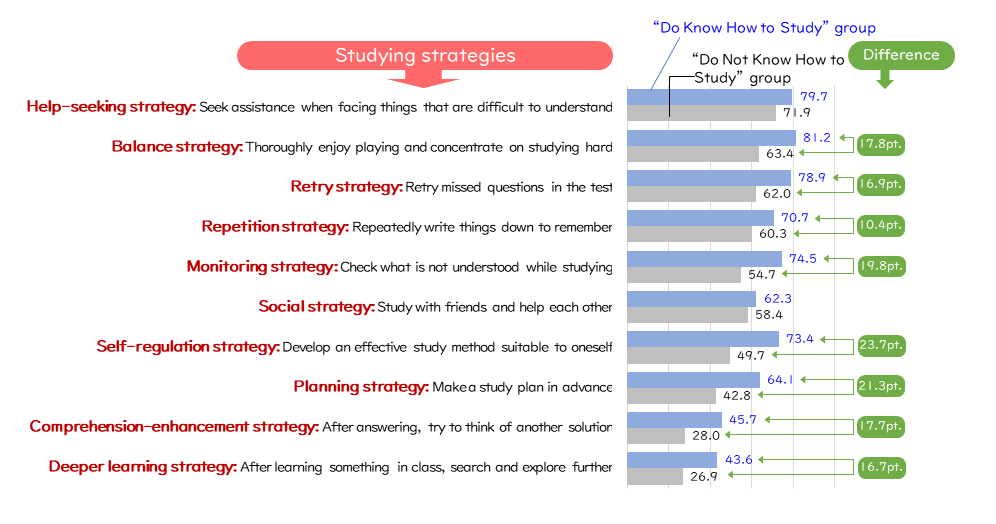Read Part 1.
3. Regarding changes in children's status of "knowing how to study" bewtween 2021 and 2022, 12.5% of the children changed from "don't know" to "do know"
Among the children who answered "I don't know how to study effectively" in the 2021 survey, 12.5% shifted to "I know how to study" in the 2022 survey."

- Children were divided into two groups based on their answers to the question item "I don't know how to study effectively." One group is those who answered "Do not know how to study" (who chose "strongly agree" or "somewhat agree") and the other group is those who answered "Do know how to study" (who chose "somewhat disagree" or "strongly disagree")
- We conducted an analysis by tracking the data of 4th-11th graders starting from 2021 who became 5th-12th graders in 2022. The number of samples was 6,816 who participated in both the 2021 and 2022 surveys (excluding those whose answers were not available). The above percentages were calculated by placing equal weighting on "4th-6th graders," "7th-9th graders," and "10th-12th graders."
As a result of our analysis by tracking changes between 2021 and 2022 regarding the children who chose the answer "I don't know how to study effectively," we confirmed that the "Keep 'Not Knowing'" group was predominant (47.4%), followed by the "Keep 'Knowing'" group ( 20.6%). By adding them together, these two groups (showed no change since 2021) accounted for 68.0%.
In contrast, the "Shifting to 'Do Know'" group accounted for 12.5%, while the "Shifting to 'Do Not Know'" group accounted for 19.5%. Because older children are more likely to answer, "I don't know how to study effectively," the occurrence rate of the "Shifting to 'Do Not Know'" group was high. It should be noted, however, that the "Shifting to 'Do Know'" group still accounted for more than 10%.
4. Once children "know how to study," their "motivation for learning" also improved
Next, we examined the relationship between changes in the children's status of "knowing how to study" and "motivation for learning" between 2021 and 2022. The occurrence rate of "improved learning motivation" was high among the "Shifting to 'Do Know'" group. In contrast, the occurrence rate of "decreased learning motivation" was high among the "Shifting to 'Do Not Know'" group. These results proved a correlation between children's know-how of studying and their motivation for learning.

- For the factor of "knowing how to study," we divided the participant children into two groups based on their answers to the question item "I don't know how to study effectively." One group is "Do Not Know How to Study" (who chose "strongly agree" or "somewhat agree") and the other group is "Do Know How to Study" (who chose "somewhat disagree" or "strongly disagree"). Then, we further divided these two groups into four groups based on their changes between 2021 and 2022.
- For the factor of "motivation for learning," we divided the participant children into two groups based on their answers to the question item "I do not feel like studying." One goup is the "weak learning motivation" group (who chose "strongly agree" or "somewhat agree") and the other is "strong learning motivation" group (who chose "somewhat disagree" or "strongly disagree"). Then, we further divided these two groups into four groups based on their changes between 2021 and 2022.
- We conducted the analysis by tracking the data of 4th-11th graders starting from 2021 who became 5th-12th graders in 2022. The number of samples was 6,805 who participated in both the 2021 and 2022 surveys (excluding those whose answer were not available). The above shows percentages calculated by placing equal weighting on "4th-6th graders," "7th-9th graders," and "10th-12th graders."
After dividing and analyzing the participant children into four groups based on changes in their knowledge of how to study, we confirmed a correlation between changes in their "knowing how to study" and "motivation for learning."
The occurrence rate of "keeping strong motivation for learning" was high among the "keep 'knowing'" group. This result indicates that children who constantly know how to study can keep strong motivation for learning. In contrast, the occurrence rate of "keeping weak motivation" was high among the "keep 'Not knowing'" group.
Meanwhile, the occurrence rate of "improved motivation for learning" was high among the "shifting to 'Do know'" group (meaning children who did not know how to study in 2021 but came to know how in 2022). In contrast, the occurrence rate of "decreased motivation for learning" was high among the "shifting to 'Do not know'" group (meaning children who knew how to study in 2021 but did not know how in 2022).
5. Once children "know how to study," their "school performance" also improved
We examined the correlation between changes in children's status of "knowing how to study" and "academic achievements" between 2021 and 2022. The occurrence rate of "higher academic achievements" was high among the "shifting to 'Do know'" group. In contrast, the occurrence rate of "lower academic achievements" was high among the "shifting to 'Do not know'" group.

- Children's "academic achievements" were converted into deviation values, using the average values ranging from 1 (the lowest) to 5 (the highest) of four subjects (Japanese language, mathematics, science, and social studies) for children in 4th grade, and five subjects (Japanese language, mathematics, science, social studies, and English language) for children other than those in 4th grade.
- For 10th-12th graders, some did not take certain subjects. In such cases, the deviation value of "3" was assigned automatically. Changes in academic achievements were expressed by changes in deviation values confirmed in the 2022 survey (from the starting point (0) allocated in the 2021 survey). The four groups representing whether children know how to study were created in the same way as explained in Figure 3.
- The analysis was conducted by tracking the data of 4th-11th graders starting from 2021 who became 5th-12th graders in 2022. The number of samples was 6,551 who participated in both the 2021 and 2022 surveys (excluding those whose answers were not available). The above shows values calculated by placing equal weight on "4th-6th graders," "7th-9th graders," and "10th-12th graders."
- ***p<0.001 (as a result of multiple comparisons)
After dividing the participant children into four groups based on changes in their knowing how to study and analyzing changes in their academic achievements (converted into deviation values) between 2021 and 2022, we confirmed that there was a correlation between changes in their "knowing how to study" and "academic results."
For the "Shifting to 'Know'" group, the score of academic achievements increased by 1.8 points. In contrast, the score of academic achievements increased by 0.4 points for the "Keep 'Knowing'" group, 0.2 points for the "Keep 'Not Knowing'" group and decreased by 1.2 points for the "shifting to 'Do Not Know'" group. These results confirmed that once children started to know how to study their academic achievements improved, and when they did not know how to study their academic achievements deteriorated.
6. Children's "knowing how to study" also correlates with their logical thinking and persistence
When compared with the group of "Do not know how to study" (who chose "strongly agree" or "somewhat agree" to the question item "I don't know how to study effectively"), children in the group of "Do know how to study" (who chose "somewhat disagree" or "strongly disagree") were better at logical thinking and capable of making steady efforts to accomplish something, regardless their level of academic scores.

- We divided the participant children into two groups based on their answers to the question item "I don't know how to study effectively." That is the group of "Do Not Know How to Study" (who chose "strongly agree" or "somewhat agree") and the group of "Do Know How to Study" (who chose "somewhat disagree" or "strongly disagree").
- The number of samples was 8,682. The above percentages were calculated by placing equal weighting on "4th-6th graders," "7th-9th graders," and "10th-12th graders."
The children's status of "knowing how to study" correlates not only with their academic achievements but also with various capabilities, such as logical thinking and persistence.
When asked about the capability of logical thinking, more children with higher academic scores answered that they are good at logical thinking. To sum up, the majority of children from the "knowing how to study" group answered so, regardless of the level of their academic scores.
When asked about persistence (being capable of making steady efforts to accomplish something), more children with higher academic scores answered that they were persistent. To sum up, the majority of children from the "knowing how to study" group answered so, regardless of the level of their academic scores.
7. Children who know how to study are trying various studying strategies
The group of "Knowing how to study" (who chose "somewhat disagree" or "strongly disagree" to the question item "I don't know how to study effectively") practiced various studying strategies than the group of "Do not know how to study" (who chose "strongly agree" or "somewhat agree"). In particular, there was a large disparity between the two groups regarding self-regulation strategy, study planning strategy, and monitoring strategy.

- The above represents the aggregated percentage of "Often do" and "Sometimes do" calculated based on the 2022 survey data.
- We divided the participant children into two groups based on their answers to the question item "I don't know how to study effectively." One group is "Do Not Know how to study" (who chose "strongly agree" or "somewhat agree") and the other group is "Do Know How to Study" (who chose "somewhat disagree" or "strongly disagree").
- The above shows percentage calculated by placing equal weighting on "4th-6th graders," "7th-9th graders," and "10th-12th graders."
Children use various studying strategies daily. However, the survey results revealed that children who agreed to the question item "I don't know how to study effectively" (i.e., the group of "Do Not Know How to Study") used fewer studying strategies than the group of "Do Know How to Study."
There are significant differences between the group of "Do Know How to Study" and the group of "Do Not Know How to Study" regarding the "Self-regulation strategy" (difference: 23.7 points), "Planning strategy" (difference: 21.3 points), and "Monitoring strategy" (difference: 19.8 points). In particular, using strategies with a metacognitive approach to view oneself objectively and adjust themselves as the child learns seems to boost children's status of knowing how to study.
Other strategies associated with children's status of knowing how to study include the "Balance strategy" (keeping one's concentration while studying; difference: 17.8 points), "Comprehension-enhancement strategy" (multi-dimensional thinking; difference: 17.7 points), "Retry strategy" (reflective learning; difference: 16.9 points), and "Deeper-learning strategy" (further exploring what they learned; difference: 16.7 points).
To be continued in Part 3.














